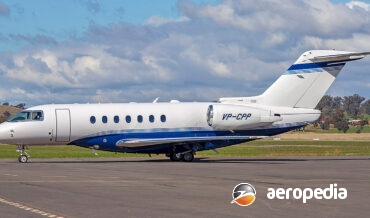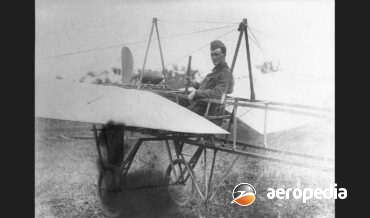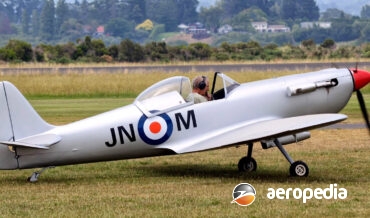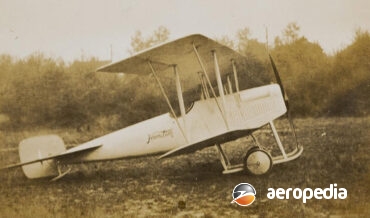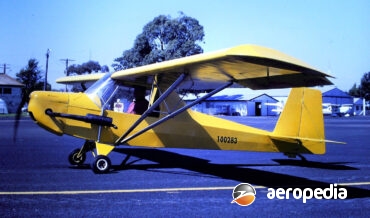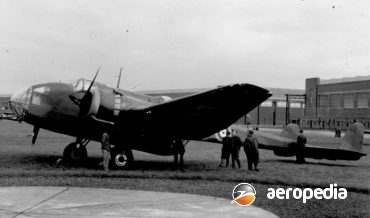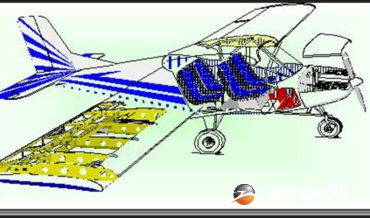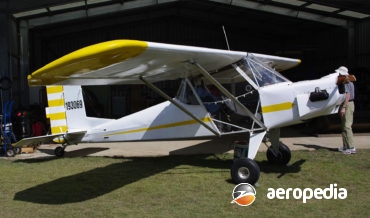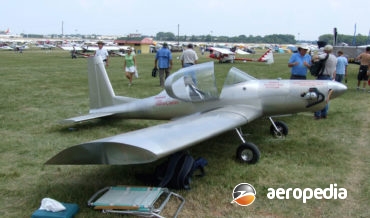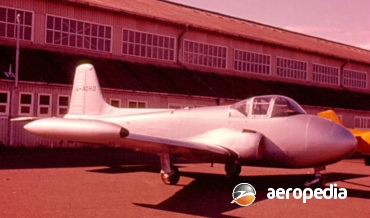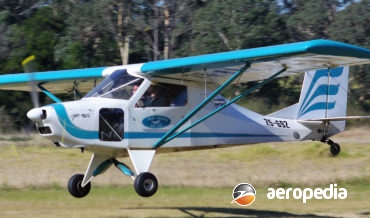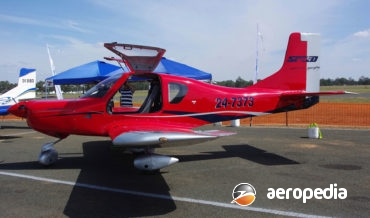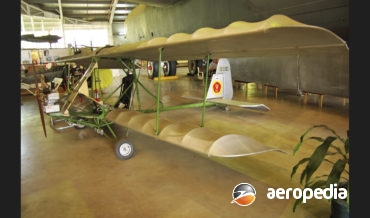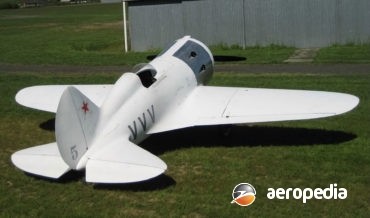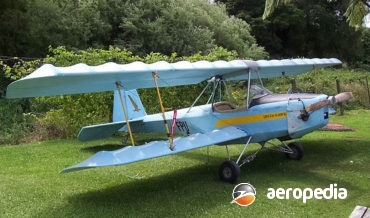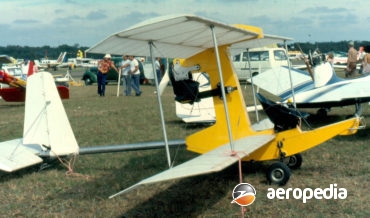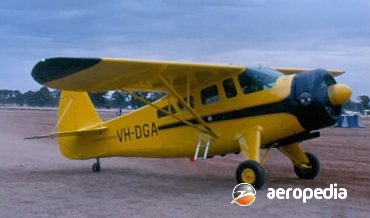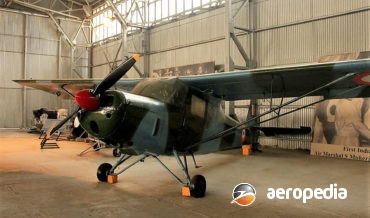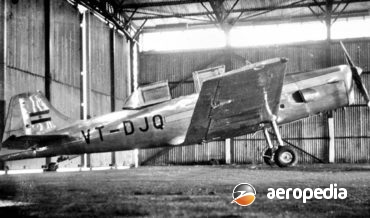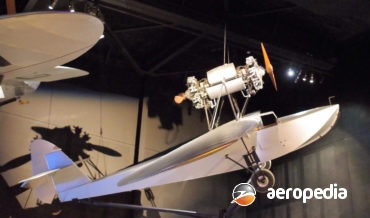All Contents
Contents
Photograph: Hawker 4000 CP-CPP (c/n 7625) at Wagga Wagga, NSW, in May 2019 (Robert Myers) Country of origin: United States of America Description: Business and executive aircraft Power Plant: Two 6,900 lbst Pratt & Whitney (Canada) PW308A turbofans Specifications: Wingspan: 18.82 m (61 ft 9 in) Length: 21.18 m (69
David C. Eyre
- November 26, 2020
The Mosquito was an ultralight designed and built in Australia for the local market. It was powered by a 16.4 kw (22-hp) Skylark engine.
David C. Eyre
- May 25, 2020
The Hi Jack is another ultralight built for the Australian market. Power plant was the popular at the time 16.4 kw (22-hp) Skylark engine.
David C. Eyre
- May 25, 2020
In about 1916 during World War I James Hayden of Narromine, NSW built a light aircraft on his property Acton along the lines of a Bleriot XI with wing warping and powered by two converted motor-cycle engines coupled and driving a single propeller.
David C. Eyre
- May 25, 2020
The Hawkeye is an ultralight aircraft designed and built by its owner as a one-off aircraft. It was designed as a scale replica of the Piper L-4 observation aircraft and when completed was painted in an overall green colour scheme and markings of a US Army Air Force aircraft in
David C. Eyre
- May 25, 2020
Little is known about this aircraft but it was designed and built by the late Ole Hartmann and, fitted with a Rotax 503 engine, it became 19-3746 (c/n 1) under RAA regulations.
David C. Eyre
- May 25, 2020
This is an amateur designed and built aircraft which resembles a Supermarine Spitfire in looks and is powered by an ultralight engine.
David C. Eyre
- May 25, 2020
A Hamilton biplane was flown by Messrs Seaforth and MacKenzie out of a paddock at Martin, NZ in 1913, this being the first flight by a heavier than air machine in the Manawatu area.
David C. Eyre
- May 25, 2020
Australian philanthropist, Sir Edward Hallstrom, based in Sydney, was well known, amongst other things, for the design, development, production and marketing of the Hallstrom series of refrigerators, which became a by-word for efficiency at the time.
David C. Eyre
- May 25, 2020
Little is known about this aircraft. It is a scaled down Piper J-3 Cub designed and built by the owner and is a single-seater and is painted overall yellow and is powered by a Rotax 277 engine.
David C. Eyre
- May 25, 2020
In July 1988 it was announced a Swedish inventor of the World’s first cardboard aircraft “which is also radar-proof and fire-resistant”, was setting up business in Australia.
David C. Eyre
- May 25, 2020
This was a one-off single-seat parasol wing aircraft painted light blue with dark blue trim which became 10-1887 (c/n 1) under RAA regulations.
David C. Eyre
- May 25, 2020
The Hummingbird is a high-performance gyrocopter designed and built in Brazil at Joinville, which is between Florianopolis and Curitaba on the south Brazilian coastline.
David C. Eyre
- May 25, 2020
The TH1 is a single-seat light aircraft built at Leom, New Zealand, in the 1980s. It was one of the first indigenous-designed light aircraft to be completed in New Zealand and is said to be based on the design of the North American P-51 Mustang.
David C. Eyre
- May 25, 2020
This aircraft was noted at an air-show at Aero Pelican, Belmont, NSW in September 1964. The machine was unfinished and was said to have been submitted to the Army Inventions Commission in 1943.
David C. Eyre
- May 25, 2020
Very little is known about this aircraft. It was first registered with Recreation Aviation Australia on 4 December 2008 but nothing further is known about it.
David C. Eyre
- May 25, 2020
Known affectionately as Flying Tadpole, and the flying suitcase, the Hampden was one of the mainstays of RAF Bomber Command in the early years of World War II.
David C. Eyre
- August 24, 2019
At the conclusion of fighting in the Spanish Civil War in April 1939 the Nationalist air arm possessed some 40 Messerschmitt Bf 109Bs and a number of Bf 109Es.
David C. Eyre
- August 24, 2019
In late 1999 Hughes Engineering of Ballina, NSW, announced it proposed to put into production a four-seat kit aircraft designed by students from the University of New South Wales Engineering School, the latter having been commissioned to design the aircraft earlier that year.
David C. Eyre
- August 24, 2019
The P R Breeze is a single-seat variant of the PR-582 Pocket Rocket using the basic Lightwing fuselage, but fitting it with a single parasol configuration wing and installing a range of Rotax engines, including the Models 582, 503 or 618 two strokes, or the Rotax 912 four-stroke.
David C. Eyre
- August 24, 2019
The Hummelbird was designed by Maurice ‘Morry’ Hummel, and is marketed by Hummel Aviation of Bryan, Ohio, in kit form as a light single-engine single-seat low-cost fast-build, high-performance aircraft.
David C. Eyre
- August 24, 2019
The Ultra Cruiser was designed by Maurice Hummel and is produced by Hummel Aviation for the ultralight and sporting aircraft market and is available in kit form or as plans only form but may also be obtained as a read-to-fly aircraft.
David C. Eyre
- August 24, 2019
The P-84 Jet Provost was developed as a private venture utilising a considerable proportion of the structure of the piston-engine P-56 Provost, which was then in service with the RAF as a basic trainer.
David C. Eyre
- August 24, 2019
Construction of the prototype of the Lightwing series began in 1984 and, initially known as the GA-55, it flew for the first time in June 1986 and was built as a ‘micro-light’ to meet ANO 101-28.
David C. Eyre
- August 24, 2019
The Lightwing Speed was designed and built by the Hughes Lightwing Co at Ballina, NSW to be produced in kit form for the light aircraft market, being produced in four basic versions, the two-seater known as the SP2000-S which is a lightweight models for registration under Recreation Aircraft Australia Regulations
David C. Eyre
- August 24, 2019
The Hevle Classic is two-seat development of the Bowers or EAA Fly Baby which was designed as a simple, easy to fly, low-coast light aircraft for the amateur builder.
David C. Eyre
- August 24, 2019
The Delta Bird is one of a series of ultralight aircraft designed by Robert Hovey in 1982. It is a single-seat single-engine biplane with conventional three-axis control.
David C. Eyre
- August 24, 2019
In New Zealand Volker Heydecke built an all-composite 66-percent scale replica of a Polikarpov I-16 Type 24 fighter and it was fitted with a 112-kw (150-hp) Rotec R3600 radial engine with a 3:2 gearing.
David C. Eyre
- August 24, 2019
The Delta Hawk is a light single-seat sporting biplane which was available in the 1980’s in kit form in the United States, being designed by Mr R W Hovey of California.
David C. Eyre
- August 24, 2019
During the 1930s Mr Percy Hick of Ballingal, near Griffith, NSW, with the assistance of his two brothers Stanley and Allan, built two aircraft.
David C. Eyre
- August 24, 2019
The Whing Ding was designed by Mr R W Hovey as an ultra-light aircraft which would require minimal construction time, would have STOL performance, and capable of easy dis-assembly for transportation and storage.
David C. Eyre
- August 24, 2019
Stanley Hill Jr designed the Model 360 helicopter and offered it for commercial sale in 1948. Subsequently the designation Hiller 360 was dropped in favour of UH-12, and later models were known simply as the 12C, 12E, etc.
David C. Eyre
- August 24, 2019
The DGA-15 was the last of a series of high-performance monoplanes built by Howard Aircraft Corp at St Charles, Illinois in the United States.
David C. Eyre
- August 24, 2019
The Praga E.114 was designed by Jaroslav Slechta in Czechoslovakia and initially built by CKD Praga, where it became known as the Air Baby.
David C. Eyre
- August 24, 2019
The brothers, Leo Austin Walsh was born in Bradford, Yorkshire, in 1881 the family emigrating to Auckland in 1883. His brother, Vivian Claude Walsh was born in New Zealand in 1888.
David C. Eyre
- August 24, 2019
The Krishak was manufactured by Hindustan Aeronautics Ltd of Bangalore as the HAOP-27 air-observation post and liaison monoplane for the Indian Air Force to replace the Auster AOP-9.
David C. Eyre
- August 24, 2019
The 304 MS Shark is one of a range of high performance gliders designed in Germany and built by HpH Ltd in the Czech Republic and is a single-seater of composite construction available in the 15-metre Class up to the two-seat 20-metre Open Class and was developed from the German
David C. Eyre
- August 24, 2019
The HT-2 was designed by Dr V M Ghatge, Chief Designers of Hindustan Aircraft Ltd at Bangalore, India.
David C. Eyre
- August 24, 2019
In 1955 the aircraft division of the Hughes Tool Co designed and developed a light helicopter known as the Model 269.
David C. Eyre
- August 24, 2019
The Ibis was a foray into the design and construction of a light aircraft by one of Australias most famous aviators, Herbert (Bert) John Louis Hinkler.
David C. Eyre
- August 24, 2019
Recent Comments
Archives
Categories
- No categories
Categories
- No categories
Latest Posts
Newsletter

